Students Envision Cities of the Future at Design Thinking Expo
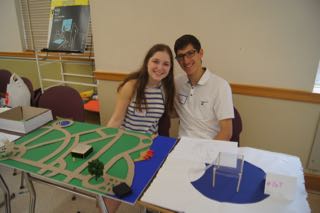 On April 27, the City 2.0 Class, taught by Maggie Favretti and Fallon Plunkett held a Design Expo to showcase their work on improving urban environments. The students came up with creative ideas to improve transportation, solve urban problems and improve the urban experience.
On April 27, the City 2.0 Class, taught by Maggie Favretti and Fallon Plunkett held a Design Expo to showcase their work on improving urban environments. The students came up with creative ideas to improve transportation, solve urban problems and improve the urban experience.
Each group built a prototype to demonstrate their concept and were available to present their ideas to visiting parents, staff members, students and the press. We toured the rooms and were very impressed with the research and design thinking behind the concepts.
Here are a few of the projects we saw:
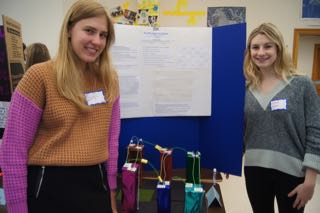 Morgan Cochrane and Jessica Cohen shared their model for moving more quickly around crowded city streets. They envisioned an elevated cable car system to transport pedestrian north and south and east and west. Elevators would lift users up to the elevated system powered by solar energy.
Morgan Cochrane and Jessica Cohen shared their model for moving more quickly around crowded city streets. They envisioned an elevated cable car system to transport pedestrian north and south and east and west. Elevators would lift users up to the elevated system powered by solar energy.
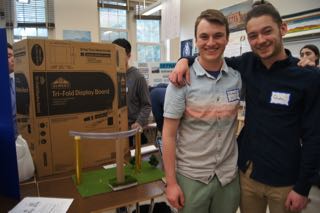 Michael McCormick, Owen Hall and Harrison Novick proposed to move the subway from below ground to above ground in an elevated system of clear tubes where the train system would be powered by magnets. This would be safer, decrease congestion and improve energy efficiency.
Michael McCormick, Owen Hall and Harrison Novick proposed to move the subway from below ground to above ground in an elevated system of clear tubes where the train system would be powered by magnets. This would be safer, decrease congestion and improve energy efficiency.
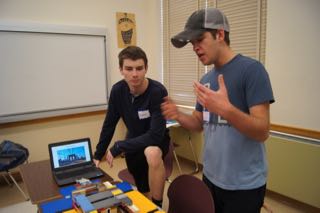 If you've ever been stalled in traffic on one of the tri-state areas bridges, you'll appreciate this project redesignsing a bridge to expand the number of lanes and to provide dedicated lanes for emergency vehicles. Andrew Shemberg, Matt Stern and Arlen Tzamarot built a nine lane, multi-level bridge to solve the eternal issue of traffic.
If you've ever been stalled in traffic on one of the tri-state areas bridges, you'll appreciate this project redesignsing a bridge to expand the number of lanes and to provide dedicated lanes for emergency vehicles. Andrew Shemberg, Matt Stern and Arlen Tzamarot built a nine lane, multi-level bridge to solve the eternal issue of traffic.
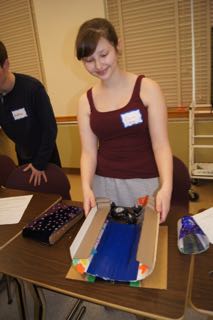 Remi Bernstein, Claire Gillespie and Melinda Orengo also considered transportation, coming up with a new concept for a tunnel. They envisioned an oval-shaped tunnel to provide more open space and light with white and yellow lights in the ceiling to simulate the night sky. The tunnel would also include wide paths for pedestrians and bikers.
Remi Bernstein, Claire Gillespie and Melinda Orengo also considered transportation, coming up with a new concept for a tunnel. They envisioned an oval-shaped tunnel to provide more open space and light with white and yellow lights in the ceiling to simulate the night sky. The tunnel would also include wide paths for pedestrians and bikers.
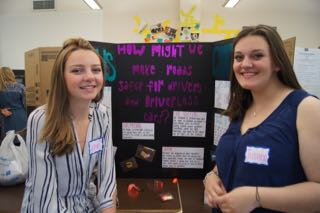 Justine Lionti and Sophie Pendrill approached driving safety by envisioning roads lined with sensors to guide driverless cars. These would decrease the incidence of accidents and save money.
Justine Lionti and Sophie Pendrill approached driving safety by envisioning roads lined with sensors to guide driverless cars. These would decrease the incidence of accidents and save money.
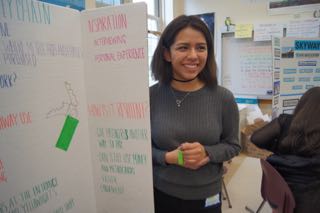 Emily Rodriguez demonstrated her key fob EZPass for public transportation, which would allow the user to swipe their fob to enter the system and have funds deducted from their account. Imagine how much easier that would be than fumbling for your metro card.
Emily Rodriguez demonstrated her key fob EZPass for public transportation, which would allow the user to swipe their fob to enter the system and have funds deducted from their account. Imagine how much easier that would be than fumbling for your metro card.
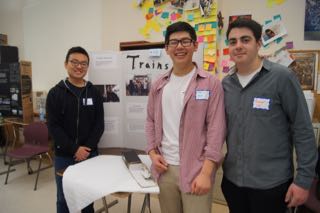 Afraid of catching a cold – or something worse – while riding the subway? This team (Jinyi Huang, Matthew Li and Michael Litton) envisioned self-cleaning trains designed with Parx Plastics, which are anti-bacterial materials that clean themselves, preventing the spread of germs between riders.
Afraid of catching a cold – or something worse – while riding the subway? This team (Jinyi Huang, Matthew Li and Michael Litton) envisioned self-cleaning trains designed with Parx Plastics, which are anti-bacterial materials that clean themselves, preventing the spread of germs between riders.
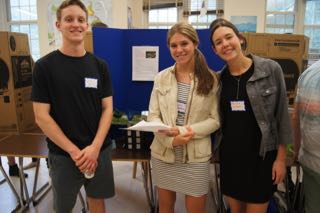 Linked multi-use sustainable rooftops would increase green space in the city and provide areas for gardening and recreation. Caitlin D'Ambrosio, Alex Quill, Christina Siekierski displayed their model for linked roofs where users could plant vegetable gardens, enjoy picnics or even musical performances.
Linked multi-use sustainable rooftops would increase green space in the city and provide areas for gardening and recreation. Caitlin D'Ambrosio, Alex Quill, Christina Siekierski displayed their model for linked roofs where users could plant vegetable gardens, enjoy picnics or even musical performances.
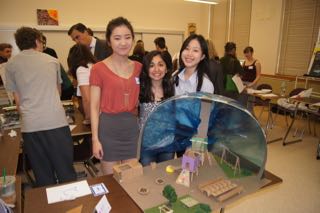 Wen Yi See, Catherine Zhao and Zoya Binyaminov visited Russel Sage Park in Queens to see how it could be redesigned for better use. It's currently cold and unfriendly. They proposed adding grassy areas, picnic tables and barbeque pits and even installing charging stations so that residents could relax in their neighborhood park A large, moveable glass dome could descend and cover the park at night and clean the entire area with UV rays.
Wen Yi See, Catherine Zhao and Zoya Binyaminov visited Russel Sage Park in Queens to see how it could be redesigned for better use. It's currently cold and unfriendly. They proposed adding grassy areas, picnic tables and barbeque pits and even installing charging stations so that residents could relax in their neighborhood park A large, moveable glass dome could descend and cover the park at night and clean the entire area with UV rays.
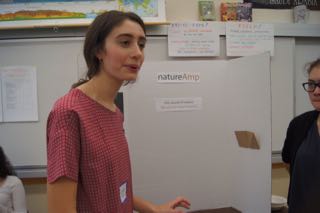 Lilah Cooperman and Olivia Leone presented a plan to echo and amplify the sounds of nature in park spaces, increasing relaxation and decreasing city noise.
Lilah Cooperman and Olivia Leone presented a plan to echo and amplify the sounds of nature in park spaces, increasing relaxation and decreasing city noise.
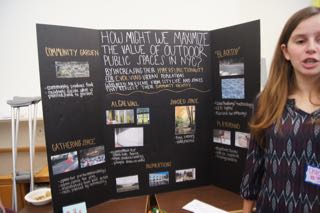 Chloe Suzman and Harris Gelblum designed a multi-functional energy generating public park. Built with algae walls and solar roadways, park fixtures and seating would be made of a fungus that comes from mushrooms called mycelium that can be reshaped and reworked into new fixtures as the need arises.
Chloe Suzman and Harris Gelblum designed a multi-functional energy generating public park. Built with algae walls and solar roadways, park fixtures and seating would be made of a fungus that comes from mushrooms called mycelium that can be reshaped and reworked into new fixtures as the need arises.
This exercise in design thinking produced an impressive range of projects to improve the urban landscape. Let's hear it for the cities of the future.